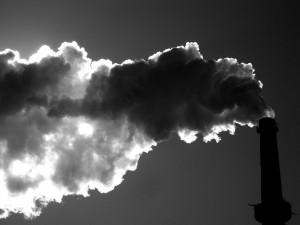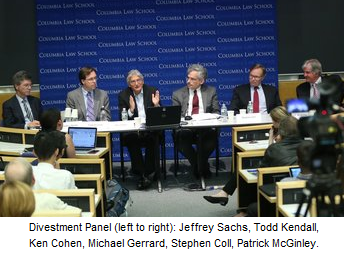 By Michael B. Gerrard, Director
By Michael B. Gerrard, Director
The Paris Agreement on climate change reached on December 12, 2015 has a heavily negotiated sentence that, when closely read, seems to call for the virtual end of fossil fuel use in this century unless there are major advances in carbon sequestration or air capture technology. That, in turn, has important legal implications.
Article 4 Par. 1 says, “In order to achieve the long-term temperature goal … Parties aim to reach global peaking of greenhouse gas emissions as soon as possible … and to achieve rapid reductions thereafter in accordance with best available science, so as to achieve a balance between anthropogenic emissions by sources and removals by sinks of greenhouse gases in the second half of this century.”
In other words, what goes up should be taken back down: for every ton of greenhouse gases (GHGs) emitted from a smokestack, tailpipe or chopped tree, a ton should be removed.
The Numbers
According to the Intergovernmental Panel on Climate Change’s Fifth Assessment Report (2014), fossil fuel use emits about 32 gigatons of carbon dioxide per year. Other sources, such as methane leakage, cement manufacture, and other industrial processes add another 5-7 gigatons carbon dioxide equivalent. Deforestation and agriculture, forestry and other land use changes (but subtracting emissions sequestered by forest growth) add yet another 10-12 gigatons a year. This all adds up to about 49 gigatons. However, global carbon sinks remove only about 18 gigatons per year (8.8 to the oceans, 9.2 to land, not including land use changes).
Thus the sinks take up about the equivalent of the non-fossil sources. In order to achieve a “balance” between emissions and sinks, we need to just about end the release of GHGs from fossil fuels, though a radical increase in sinks or reduction of non-fossil fuel emissions would provide some slack.
Assuming that some kind of balance between emissions and sinks can be achieved, would we actually have until 2099 to decarbonize the economy, as these numbers imply is needed? Not really. Kelly Levin, Jennifer Morgan and Jiawei Song at the World Resources Institute provide here an illuminating overview of what is required to achieve the long-term temperature goal in Article 2 of the Paris Agreement (“holding the increase in global average temperature to well below 2° C above pre-industrial levels and to pursue efforts to limit temperature increase to 1.5° C”). As the WRI post notes, a recent paper in Nature Climate Change suggests that carbon dioxide from electricity would have to be brought close to zero by 2050, and by then around 25 per cent of energy required for transportation would also need to come from electricity (up from less than one per cent now).
There seem to be only three ways to continue to use fossil fuels for electricity in the second half of the century (and for transport by the end of the century) and still meet the temperature goal:
- Capture the carbon before it escapes into the air, and sequester it
- Devise, and deploy on a massive scale, technologies to remove the carbon from the air, and sequester it
- Create new sinks, such as through the immediate halt to deforestation and a worldwide program of tree planting
All three of these raise a question of how long the carbon will be stored; we do not know how long carbon will stay in reservoirs, and we do know that trees do not live forever, and when they burn or die they release their carbon. Moreover, the technologies of carbon capture and sequestration, and of removing carbon from the ambient air, are developing slowly and are nowhere near large scale deployment. (A price on carbon would create an economic incentive to develop and use these technologies, but politicians in most places are unwilling to impose such a price. A large-scale government-funded research effort, such as the ones that put human beings on the moon, could also produce the necessary innovation, but there has been little visible support for such an effort.) Most of the industrial carbon sequestration that now occurs goes toward “enhanced oil recovery” – squeezing oil out of depleted reservoirs – but extracting more oil is not compatible with stopping fossil fuel use.
Finding the land for large scale tree planting would face its own challenges in a world where sea level rise, persistent drought, and extreme heat will be rendering much land unsuitable for growing food.
So meeting the demands of society for energy means a combination of aggressive energy efficiency and conservation programs, the installation of renewable energy (and, perhaps, nuclear), and the substitution of electric or hydrogen vehicles for those using petroleum at an unprecedented pace. The Deep Decarbonization Pathways Project has set forth the colossal amount of new facility construction that would be required worldwide to achieve this.
Legal Implications
The Paris Agreement calls on all countries to strengthen their pledges to reduce GHG emissions, and to monitor their progress and report it to the world. It also says that “all parties should strive to formulate and communicate long-term low greenhouse gas emission development strategies” (Article 4 Par. 19) That looks like strategies under which every country must show how it is controlling its fossil fuel use.
These provisions are not legally enforceable. However, many domestic laws are, and they will become a powerful tool to force early planning, or at least disclosures. One key example is the securities disclosure requirements for publicly traded companies. On January 27, 2010, the U.S. Securities and Exchange Commission issued guidance for the disclosure of climate-related risks. It specifically calls on companies to “consider, and disclose when material, the impact on their business of treaties or international accords relating to climate change.” The Paris Agreement is clearly such an accord, and (if it is vigorously implemented) it will have material impact on many companies in the business of extracting, processing and using fossil fuels, or making things that rely on fossil fuels (such as motor vehicles, ships and airplanes). The SEC’s guidance makes clear that management’s discussion and analysis should explore known trends and uncertainties concerning climate regulation. This includes regulation outside the U.S. that can affect the operations abroad of U.S. companies. Therefore disclosure can be expected of the effect of severe restrictions here or in other countries on fossil fuel use, including the possibility that most fossil fuel reserves will need to stay in the ground.
Climate disclosures have received increased attention since it was reported in November that New York Attorney General Eric Schneiderman is investigating ExxonMobil under the New York securities law, the Martin Act, over its statements about climate change, and had reached a settlement with Peabody Energy.
This is not necessarily limited to U.S.-registered companies. For example, in April 2015 the G20 finance ministers and central bank governors asked the U.K. Financial Stability Board for advice on the financial stability implications of climate change. In November 2015 this Board proposed the establishment of a disclosure task force to develop voluntary disclosures for several climate-related risks, including “the financial risks which could result from the process of adjustment towards a low-carbon economy.”
Going forward, impact review of energy projects under the National Environmental Policy Act and its counterparts in many states and most other developed countries should consider the phaseout of fossil fuels that is inherent in the Paris Agreement. For example, a proposal to build or finance a coal mine, a coal-fired power plant, or a coal port should consider whether the facility would need to be closed before the end of its otherwise useful life, and whether the project would be inconsistent with the Agreement.
Systematic analysis and disclosure of these risks will lead responsible boards of directors to undertake serious planning to effect an orderly transition to the low-carbon world that 188 countries agreed to in Paris. These disclosures will also help investors decide what companies will thrive in such a world (such as developers of technologies for renewable energy and efficiency), and what companies are failing to prepare for the transition and thus will themselves become fossils.




